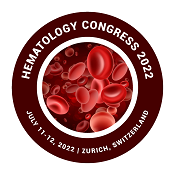
Ramachandran Muthiah
Morning Star Hospital, India
Title: Hematological manifestations of Corona Virus infection
Biography
Biography: Ramachandran Muthiah
Abstract
The corona virus is a single-stranded RNA virus and the angiotensin converting enzyme 2 receptor (ACE-2), to which SARS-CoV-2 binds for entry into cells, found in brain vascular endothelium and smooth muscle and SARS-CoV-2 replicates in the cells. It causes oedema, cell necrosis, and broad gliocyte hyperplasia. The elevated expression of the cytokine, monokine induced by gamma interferon (known as MIG or CXC L9), and with infiltration of monocytes and macrophages plus T cells are consistent with viral CNS entry, triggering the infiltration of immune cells and the release of cytokines and chemokines, which contribute to tissue damage. A vasculitis process similar to that for varicella zoster virus, in which viral replication in the cerebral arterial wall triggers local inflammation. SARS (Severe acute respiratory syndrome ) -CoV-2 can cause damage to endothelial cells, activating inflammatory and thrombotic pathways. Endothelial cell infection or monocyte activation, upregulation of tissue factors, and the release of microparticles, which activate the thrombotic pathway and cause microangiopathy. Endothelial infection by SARS-CoV-2 and stroke are consistent with a virus-associated microangiopathic process. Monocyte activation is postulated to contribute secondary haemophagocytic lymphohistiocytosis described in severe COVID-19. It is a rare hyperinflammatory condition characterized by a severe hypercytokinaemia with multiorgan failure. Thrombocytopenia with elevated D-dimer and C-reactive protein are the markers of severe COVID-19. Competitive blockage of angiotensin-converting enzyme 2 by the SARS-CoV-2 virus down-regulates angiotensin-converting enzyme 2 expression leading to uncontrolled blood pressure and the enhanced possibility of cerebrovascular accidents. Spike surface glycoprotein plays a crucial role in immunopathology. A unique furin-like cleavage site, on the spike protein, plays a crucial role in viral cell entry. Transmembrane protease, serine 2 (TMPRSS2) enzyme, is needed to activate the spike protein. A serine protease enzyme inhibitor blocks viral entry into the host cell. This phenomenon can be exploited for developing a treatment of COVID-19, in the future. Treatment with intravenous immunoglobulins lead to complete or partial recovery in the majority. Immediate anticoagulation with low-molecular-weight heparin has been recommended for patients with COVID-19 to reduce the risk of thrombotic disease

